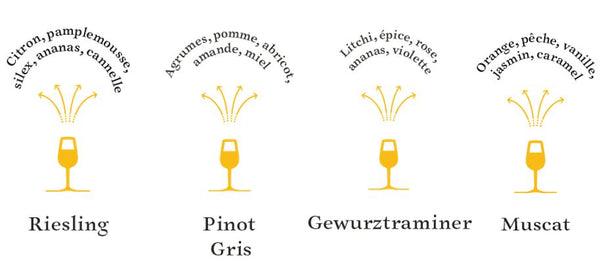Equipped with 15 600 hectares of vines, the Alsace wine region is renowned for its production of white wines exceptional . With his semi-continental climate , its varied soils as well as its magnificent wine-growing landscapes sheltered by the Vosges Mountains, it offers a unique terroir, ideal for the cultivation of numerous white grape varieties.
Among all the grape varieties of the Alsatian vineyard, 4 of them stand out and are considered noble, allowing the creation of the finest wines and being the only ones authorized (with some exceptions) to be planted on the 51 plots of the region classified as Grand Cru.
Riesling
Riesling is undoubtedly the most emblematic noble grape variety from Alsace . It produces white wines with a beautiful acidity and great finesse . Riesling-based wines regularly feature notes of citrus, white flowers, peach, and a marked mineral character The preferred terroirs for this grape variety are schist and granite soils and on the most beautiful of them, the latter can enjoy of a magnificent keeping capacity .
It is also worth noting that Riesling alone represents 21% of the region's vines and has an exceptional ability to reflect its terroir. It is also almost exclusively vinified alone but can also be used in assembly in cremants For example.
If you want to discover the most beautiful facets of Riesling, do not hesitate to turn to those of the estates Barmes-Buecher (we think in particular of the sublime Grand Cru Hengst ), Boehler ( Riesling Holderhurst ) or even Midnight Brothers (Riesling Fossils , Muehlforst Or Grand Cru Rosacker ), no disappointment possible!
Gewurztraminer
Gewurztraminer is also very present in Alsace since it represents 20% of the vineyard After Riesling, it is probably the best-known grape variety in the region and is also one of the four noble grape varieties of Alsace.
This one is able to produce dry wines but also semi-dry, sweet and sweet . Its material gives off opulence and generosity while its aroma is of rare expressiveness. It is indeed a variety that is easily identified thanks to markers such as lychee, mango, pineapple, rose as well as certain sweet spices. The terroirs favorable to Gewurztraminer are generally clay-limestone and marl.
Like Riesling, this one is capable of long aging when it comes from beautiful terroirs, like the Gewurztraminer Grand Cru Steingrubler from the Barmès-Buecher estate.
Pinot Gris
Of Burgundian origin, Pinot Gris, formerly known as Tokay (now banned since the official recognition of the eponymous Hungarian sweet wines), is a grape variety with pretty pink berries that can be vinified from dry to sweet. In fact, it often has residual sugar because it is very receptive to noble rot and benefits from being harvested when overripe (Late Harvest, Selection of Noble Grains).
He represents 16% of Alsatian vineyards and can give birth to wines of incredible richness and power , presenting a full body as well as aromas of pear, apricot, honey and spices.
Muscat
It's the 4th th noble grape variety of the region and although it only represents 4% of Alsatian vineyards , Muscat also occupies a prominent place in the region.
Unlike the Muscats of Languedoc-Roussillon or of the Rhone Valley , Muscat Alsace is very widely vinified dry and therefore generally does not have any residual sugar. However, its aromatic, fragrant and gourmet is still there : notes of fresh grapes, dates and elegant floral aromas help identify it.
PS : when we talk about Muscat in Alsace, we are actually talking about two varieties : Muscat of Alsace « small grain » and Ottonel’s Muscat.
In addition to these four noble grape varieties, Alsace also has other interesting varieties.
Pinot Blanc offers, for example, light and fresh white wines, exuding aromas of green apple and white flowers. It is often used in the region's crémants and brings roundness. This one is very present in Alsace since it is as much planted as Riesling (21% of the vineyard) !
The Sylvaner is another white grape variety present in Alsace. Once very widespread, it now only represents 5% of the vineyard . It is a variety that allows the production of dry and light white wines, expressing notes of citrus fruits and fresh herbs.
Finally, although white grape varieties represent the majority of the Alsatian vineyard (90%), The remaining 10% are planted with a red variety. : Pinot Noir . In the region, this gives rise to red wines Light to medium bodied, exhibiting delicate aromas of red fruits such as cherry, raspberry and strawberry, as well as floral and spicy notes.
Other grape varieties such as Pinot Auxerrois, Chasselas and Klevener de Heiligenstein (Savagnin rose) are also present. in the region, contributing to the great wealth of Alsatian wine.
Conclusion
You now know the 4 noble grape varieties of Alsace as well as the other main varieties of the region. Now all you have to do is move from theory to practice. ! And for that, do not hesitate to call on The Illuminated Cellar who will be happy to guide you in your choices.
Health !
















